Published: November 22, 2023

The holiday is upon us, so no need to talk about recipes (healthy and otherwise), family gathering (do’s and don’ts) and pumpkin (everything), but the spirit of thanksgiving, well that’s a weighty subject worth exploring.Here are three ways to practice gratitude.
1. Lend a hand
Many of us think about volunteering during the holidays but tend to forget that charities and their needs are year-round, 24/7.
“We’re trying to use the holidays as much as we can as a point of entry for people to get involved throughout the remainder of the year,” said Greg Baldwin, co-founder and former president of VolunteerMatch, a nonprofit that connects volunteers and charities.
This interactive site makes it easy to find volunteer opportunities (in-person and virtual) in your area, plus you can add your skills to find an even better match.
One volunteer opportunity that requires lead time (and often money and training) is medical mission and emergency response trips.
For instance, International Medical Relief offers trips to a variety of countries for both medical and non-medical volunteers, including family mission trips.
“International Medical Relief was founded in 2002 on the belief that knowledge of basic health facts and access to healthcare should not be the prerogative of select nations, regions, or classes, but should be shared by as many people as possible. During our clinics, we partner with local medical and dental professionals to share knowledge about diagnoses and treatment,” IMR explains.
Other organizations to explore include: Project C.U.R.E.; Habitat for Humanity Disaster Response; American Red Cross Disaster Action Team, and International Volunteer HQ.
2. Write a thank-you letter
If you’re like most people, you probably haven’t written a thank-you letter – (handwritten or digital) – in ages. Or maybe you send a thank-you note or card for a gift, but neglect to thank someone for their friendship, love and support.
Professor Martin Seligman, called the “father of positive psychology,” and Ryan Niemiec, creator of Mindfulness-Based Strengths Practice (MBSP), developed three steps to writing a gratitude letter.
- Take a moment to think about someone who has positively impacted your life (whether in the short or long term) that you appreciate, yet may not have thanked properly.
- Write that person a letter describing how you feel about what they have done for you and why you are grateful to them. It should be concrete, about three hundred words and specific, Seligman says. Some questions to ponder include: How and when did you both meet? What are your earliest memories of your relationship?
How was your life at the time? What has that person done for you? How did that make you feel then and now? - While this may not always be an option-or at times the right thing to do-Seligman suggests you take time reading the letter to the other person and watch for the other person’s reactions and your own. And then, when finished, discuss the content with them.
In a 2005 study, Seligman compared writing gratitude letters with other positive psychological interventions and found the letters offered the greatest initial increase of happiness.
3. Start a gratitude practice
There are lots of tools to help you cultivate a gratitude practice, starting with Grateful Living. You can sign up to receive a daily “word for the day” or daily question, along with programs and events, such as “Say Yes to Joy: A 5-day practice.”
Books to help guide your practice include: “Wake Up Grateful: The Transformative Practice of Taking Nothing for Granted, ” by Kristi Nelson; books and YouTube videos by Brother David Steindl-Rast; “The Book of Delights,” by Ross Gay; and books by Thich Nhat Hanh.
There are also many gratitude journals on the market with prompts to help you discover blessings, big and small, that you can write about.
And finally consider finding a gratitude buddy to share your journey. For instance, you could text each other at the end of each day with a sentence or just a few words of what you are grateful for.
Road Map to Residency
Moving to a new home is not an easy task. But it can mean an exciting new beginning.
 In the past, Molly Kavanaugh frequently wrote about Kendal at Oberlin for the Cleveland Plain Dealer, where she was a reporter for 16 years. Now we are happy to have her writing for the Kendal at Oberlin Community.
In the past, Molly Kavanaugh frequently wrote about Kendal at Oberlin for the Cleveland Plain Dealer, where she was a reporter for 16 years. Now we are happy to have her writing for the Kendal at Oberlin Community.
About Kendal at Oberlin: Kendal is a nonprofit life plan community serving older adults in northeast Ohio. Located about one mile from Oberlin College and Conservatory, and about a 40 minute drive from downtown Cleveland, Kendal offers a vibrant resident-led lifestyle with access to music, art and lifelong learning.




